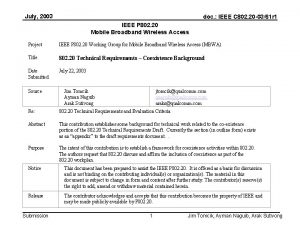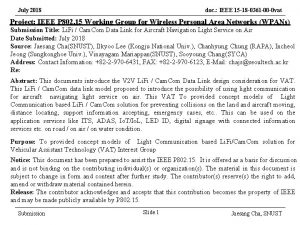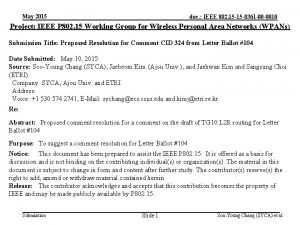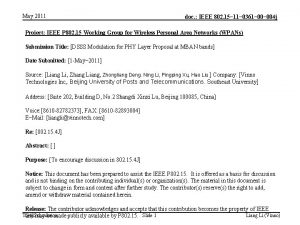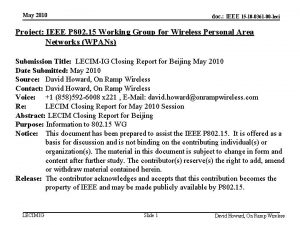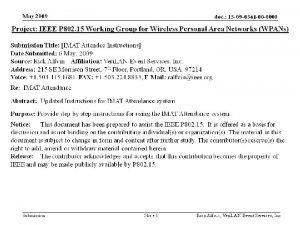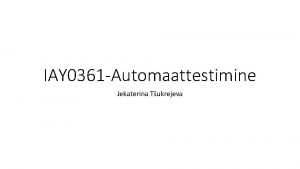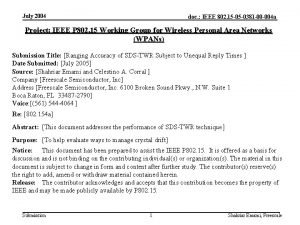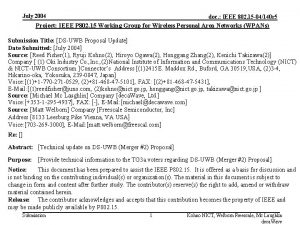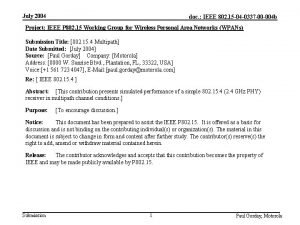July 2004 doc IEEE 802 15 04 0361
















- Slides: 16

July 2004 doc. : IEEE 802. 15 -04 -0361 -00 -003 c Project: IEEE P 802. 15 Working Group for Wireless Personal Area Networks (WPANs) Submission Title: Date Submitted: Source: Address Voice: Re: The System Model Considerations 12 July 04 Chandos A. Rypinski Company: not affiliated 130 Stewart Drive, Tiburon, CA 94920 USA +1 415 435 0642 FAX: none, E-Mail: chanryp@sbcglobal. net A system model is necessary and useful for defining many of the PHY properties. mm. Wave PHY has a number of properties that are different than those at lower frequencies. These are described and a possible plan addressing these considerations is presented. Purpose: This is a discussion only document. No action is recommended. Notice: This document has been prepared to assist the IEEE P 802. 15. It is offered as a basis for discussion and is not binding on the contributing individual(s) or organization(s). The material in this document is subject to change in form and content after further study. The contributor(s) reserve(s) the right to add, amend or withdraw material contained herein. Release: The contributor acknowledges and accepts that this contribution becomes the property of IEEE and may be made publicly available by P 802. 15. Submission 1 Chandos Rypinski

July 2004 doc. : IEEE 802. 15 -04 -0361 -00 -003 c Model Considerations for mm. Wave PHY Chandos A. Rypinski, E-m: chanryp@sbcglobal. net Consultant 12 July 2004 Submission 2 Chandos Rypinski

July 2004 doc. : IEEE 802. 15 -04 -0361 -00 -003 c Summary (1) This is description of a visualized system to support a video intensive context over a continuous area the size of a room, several rooms, studio or hall using radio transmission at 60 GHz. The offered plan describes integration of both infrastructure and device stations to obtain an excellent tradeoff of properties. It uses to advantage propagation properties often seen as drawbacks. Submission 3 Chandos Rypinski

July 2004 doc. : IEEE 802. 15 -04 -0361 -00 -003 c Summary (2) The plan uses frequency division multiplexed (FDM) working channels each used exclusively by one device. There is also a setup channel on which stations associate, disassociate and request service. Each channel uses a bandwidth of 250 MHz which supports a data transfer rate of 125 -150 Mbps with a double-sideband suppressed carrier 3 level amplitude modulation. The redundant coverage strategy is used to provide up to 4 diversity paths to each active station at distances beyond half the nominal service range of the access point. Submission 4 Chandos Rypinski

July 2004 doc. : IEEE 802. 15 -04 -0361 -00 -003 c mm. Wave radio system advantages a) There is a reliable absence of high-powered co-users of the same or nearby frequency bands b) Frequency reuse in adjacent rooms will often be feasible —the wall loss can be constructively used. c) Considering the latitude available on frequency reuse, there can be as many independent channels as are needed d) Directive antennas, with much larger capture area are small and potentially inconspicuous. Submission 5 Chandos Rypinski

July 2004 doc. : IEEE 802. 15 -04 -0361 -00 -003 c System Plan Properties(1) 1) The plan may be indefinitely extended for continuous area coverage in which user devices may move around in irregular ways. 2) Path diversity achieved with redundant overlapping coverage; and this is more effective at minimizing errors or outages than any amount of signal processing. 3) The limitation on antenna directivity at the mobile device should be restated as: the device user shall not be required to orient a directional antenna relative to an access point before use—with exceptions for non-mobile devices. Submission 6 Chandos Rypinski

July 2004 doc. : IEEE 802. 15 -04 -0361 -00 -003 c System Plan Properties (2) 4) The intelligence and the judgmental appraisals of path integrity are in the infrastructure—device modem and protocol is as simple as possible. 5) One channel has sufficient bandwidth and transmitter power to transport the data for one device. 6) The number of channels available can be sufficient for the load after considering frequency reuse and the number and geographic dispersal of users Submission 7 Chandos Rypinski

July 2004 doc. : IEEE 802. 15 -04 -0361 -00 -003 c System Plan Features—RF channelization • Each working channel is 250 MHz bandwidth supporting 125 -150 Mbps • 16/20 channels occupies 4/5 GHz at 60 GHz • There is one time-shared set-up channel outside the working channel assignment using 5 -bit spreading at 25/30 Mbps rate • At one site, every 4 th channel is used. Submission 8 Chandos Rypinski

July 2004 doc. : IEEE 802. 15 -04 -0361 -00 -003 c System Plan Features—Radio Coverage Plan • A square coverage area has one quadrantal pattern access point in each corner—each using different channel sets. • The design range for each access point is 70% of the distance to the diagonally opposite corner. • Stations further than 30% of the diagonal distance from the nearest access point will usually have coverage from more than one access point. • Stations may receive service from other than the closest access point. Submission 9 Chandos Rypinski

July 2004 doc. : IEEE 802. 15 -04 -0361 -00 -003 c System Plan Features—Area Coverage Plan • Squares may be replicated indefinitely. The square shape is desirable, but not required. • At each access point up to five channels may be installed with special provisions for more. • All access points either share a single channel with both set-up and working function or have a dedicated set-up channel. • All intelligent use this configuration depends upon centralized management aware of the status of all users and access point channels. Submission 10 Chandos Rypinski

July 2004 doc. : IEEE 802. 15 -04 -0361 -00 -003 c System Plan Features—Infrastructure • Each channel at each access point is connected to an intelligent hub switch by either “Category 6” 4 pair cable or by its radio equivalent. • When a hub exceeds 16 ports, a sub-level of hubs may be created which have concentration capability and condition traffic for a higher level hub. • All association qualification, device profiles, device status, access point and channel resource status, configuration adaptation is tracked or controlled at the intelligent hub. Submission 11 Chandos Rypinski

July 2004 doc. : IEEE 802. 15 -04 -0361 -00 -003 c System Plan Features—Access Protocol (1) • Each pre-qualified user of device may request association on the set-up channel and receive permission to use a working channel under whatever conditions the systems administrator requires. • The set-up channel is also a packet messaging channel providing whatever degree of internet access the system administrator defines. • During the association procedure, the intelligent hub determines appropriate channel and AP. Submission 12 Chandos Rypinski

July 2004 doc. : IEEE 802. 15 -04 -0361 -00 -003 c System Plan Features—Access Protocol (2) • The allotted channel may be strongly asymmetric for the ratio of up-down capacity within some limits set by simultaneous transmit and receive interference at the access point. • The payload transfer may be sub-coded for greater probability of error-free transmission. • A device transmission may be received on two or more access points at the same time requiring the switch or interposed concentrator to sort out redundant information but noting the alternative. Submission 13 Chandos Rypinski

July 2004 doc. : IEEE 802. 15 -04 -0361 -00 -003 c System Plan Features—Access Protocol (3) • On the set-up channel, there is reserved time space for all associated devices/users sufficient for service request and all’s well messages. There is no possibility of lockout due to heavy traffic. • Payloads may be transferred in 802. 15. 3 packet format or as connection-type bit streams. The hardware does not preclude either. There must be arrangements for buffering mediums of dissimilar speeds. Submission 14 Chandos Rypinski

July 2004 doc. : IEEE 802. 15 -04 -0361 -00 -003 c Positioning • The overall system might be positioned as a bridge between multiple 802 local area networks where some higher layer functions are absorbed. • This plan could use the 802. 15. 3 packet definition where the packet is relayed but not necessarily in the same way as an 802 LAN would. Submission 15 Chandos Rypinski

July 2004 doc. : IEEE 802. 15 -04 -0361 -00 -003 c Conclusion • Traffic, predominantly video for cameras and monitors, is better served by reserved paths with one path per device. This implies a multi-channel system plan with allotted channels and an intelligent infrastructure. • 60 GHz radio properties call for extensive use of directive antennas and an infrastructure that doesn’t require mobile devices to point antennas. • Wall loss should be seen as an advantage enabling more extensive frequency reuse (and requiring many more access points). Submission 16 Chandos Rypinski
 Bridges from 802.x to 802.y
Bridges from 802.x to 802.y Bridges from 802.x to 802.y
Bridges from 802.x to 802.y Ieee 802 family
Ieee 802 family Ieee 802 3 compliance
Ieee 802 3 compliance Wlan standards
Wlan standards Arquitetura ieee 802
Arquitetura ieee 802 El 802
El 802 Ieee 802 standard
Ieee 802 standard Ieee 802 bluetooth
Ieee 802 bluetooth 802 ieee
802 ieee Ieee 802
Ieee 802 Leaf yeast
Leaf yeast The harp mysteries of harris burdick
The harp mysteries of harris burdick June 22 to july 22
June 22 to july 22 Poppies in july poem
Poppies in july poem 2001 july 15
2001 july 15 February march april may june july
February march april may june july

















